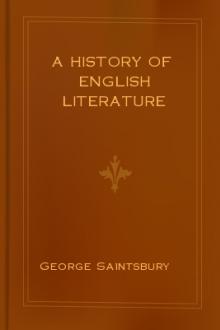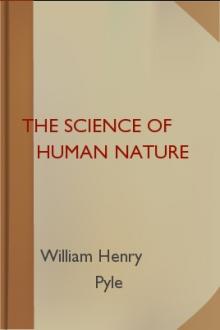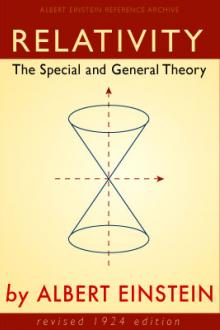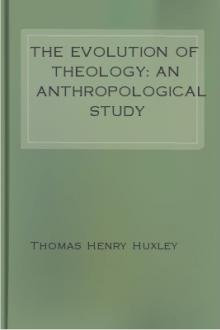Time and Tide, Sir Robert Stawell Ball [the alpha prince and his bride full story free txt] 📗

- Author: Sir Robert Stawell Ball
Book online «Time and Tide, Sir Robert Stawell Ball [the alpha prince and his bride full story free txt] 📗». Author Sir Robert Stawell Ball
virtue of the fact that it has some distance to fall before it reaches the earth. The rotating body need not necessarily have the shape of a wheel--it may be globular in form; nor need the axes of rotation be fixed in bearings, like those of the fly-wheel; nor of course is there any limit to the dimensions which the rotating body may assume. Our earth is, in fact, a vast rotating body 8000 miles in diameter, and turning round upon its axis once every twenty-three hours and fifty-six minutes. Viewed in this way, the earth is to be regarded as a gigantic fly-wheel containing a quantity of energy great in correspondence with the earth's mass. The amount of energy which can be stored by rotation also depends upon the square of the velocity with which the body turns round; thus if our earth turned round in half the time which it does at present, that is, if the day was twelve hours instead of twenty-four hours, the energy contained in virtue of that rotation would be four times its present amount.
Reverting now to the earth-moon system, the energy which that system contains consists essentially of two parts--the moon-energy, whose composite character I have already explained, and the earth-energy, which has its origin solely in the rotation of the earth on its axis. It is necessary to observe that these are essentially distinct--there is no necessary relation between the speed of the earth's rotation and the distance of the moon, such as there is between the distance of the moon and the speed with which it revolves in its orbit.
For completeness, it ought to be added that there is also some energy due to the moon's rotation on its axis, but this is very small for two reasons: first, because the moon is small compared with the earth, and second, because the angular velocity of the moon is also very small compared with that of the earth. We may therefore dismiss as insignificant the contributions from this source of energy to the sum total.
I have frequently used illustrations derived from machinery, but I want now to emphasize the profound distinction that exists between the rotation of the earth and the rotation of a fly-wheel in a machine shop. They are both, no doubt, energy-holders, but it must be borne in mind, that as the fly-wheel doles out its energy to supply the wants of the machines with which it is connected, a restitution of its store is continually going on by the action of the engine, so that on the whole the speed of the fly-wheel does not slacken. The earth, however, must be likened to a fly-wheel which has been disconnected with the engine. If, therefore, the earth have to supply certain demands on its accumulation of energy, it can only do so by a diminution of its hoard, and this involves a sacrifice of some of its speed.
In the earth-moon system there is no engine at hand to restore the losses of energy which are inevitable when work has to be done. But we have seen that work is done; we have shown, in fact, that the tides are at present doing work, and have been doing work for as long a period in the past as our imagination can extend to. The energy which this work has necessitated can only have been drawn from the existing store in the system; that energy consists of two parts--the moon-energy and the earth's rotation energy. The problem therefore for us to consider is, which of these two banks the tides have drawn on to meet their constant expenditure. This is not a question that can be decided offhand; in fact, if we attempt to decide it in an offhand manner we shall certainly go wrong. It seems so very plausible to say that as the moon causes the tides, therefore the energy which these tides expend should be contributed by the moon. But this is not the case. It actually happens that though the moon does cause the tides, yet when those tides consume energy they draw it not from the distant moon, but from the vast supply which they find ready to their hand, stored up in the rotation of the earth.
The demonstration of this is not a very simple matter; in fact, it is so far from being simple that many philosophers, including some eminent ones too, while admitting that of course the tides must have drawn their energy from one or other or both of these two sources, yet found themselves unable to assign how the demand was distributed between the two conceivable sources of supply.
We are indebted to Professor Purser of Belfast for having indicated the true dynamical principle on which the problem depends. It involves reasoning based simply on the laws of motion and on elementary mathematics, but not in the least involving questions of astronomical observation. It would be impossible for me in a lecture like this to give any explanation of the mathematical principles referred to. I shall, however, endeavour by some illustrations to set before you what this profound principle really is. Were I to give it the old name I should call it the law of the conservation of areas; the more modern writers, however, speak of it as the conservation of moment of momentum, an expression which exhibits the nature of the principle in a more definite manner.
I do not see how to give any very accurate illustration of what this law means, but I must make the attempt, and if you think the illustration beneath the dignity of the subject, I can only plead the difficulty of mathematics as an excuse. Let us suppose that a ball-room is fairly filled with dancers, or those willing to dance, and that a merry waltz is being played; the couples have formed, and the floor is occupied with pairs who are whirling round and round in that delightful amusement. Some couples drop out for a while and others strike in; the fewer couples there are the wider is the range around which they can waltz, the more numerous the couples the less individual range will they possess. I want you to realize that in the progress of the dance there is a certain total quantity of spin at any moment in progress; this spin is partly made up of the rotation by which each dancer revolves round his partner, and partly of the circular orbit about the room which each couple endeavours to describe. If there are too many couples on the floor for the general enjoyment of the dance, then both the orbit and the angular velocity of each couple will be restricted by the interference with their neighbours. We may, however, assert that so long as the dance is in full swing the total quantity of spin, partly rotational and partly orbital, will remain constant. When there are but few couples the unimpeded rotation and the large orbits will produce as much spin as when there is a much larger number of couples, for in the latter case the diminished freedom will lessen the quantity of spin produced by each individual pair. It will sometimes happen too that collision will take place, but the slight diversions thus arising only increase the general merriment, so that the total quantity of spin may be sustained, even though one or two couples are placed temporarily _hors de combat_. I have invoked a ball-room for the purpose of bringing out what we may call the law of the conservation of spin. No matter how much the individual performers may change, or no matter what vicissitudes arise from their collision and other mutual actions, yet the total quantity of spin remains unchanged.
Let us look at the earth-moon system. The law of the conservation of moment of momentum may, with sufficient accuracy for our present purpose, be interpreted to mean that the total quantity of spin in the system remains unaltered. In our system the spin is threefold; there is first the rotation of the earth on its axis, there is the rotation of the moon on its axis, and then there is the orbital revolution of the moon around the earth. The law to which we refer asserts that the total quantity of these three spins, each estimated in the proper way, will remain constant. It matters not that tides may ebb and flow, or that the distribution of the spin shall vary, but its total amount remains inflexibly constant. One constituent of the total amount--that is, the rotation of the moon on its axis--is so insignificant, that for our present purposes it may be entirely disregarded. We may therefore assert that the amount of spin in the earth, due to its rotation round its axis, added to the amount of spin in the moon due to its revolution round the earth, remains unalterable. If one of these quantities change by increase or by decrease, the other must correspondingly change by decrease or by increase. If, therefore, from any cause, the earth began to spin a little more quickly round its axis, the moon must do a little less spin; and consequently, it must shorten its distance from the earth. Or suppose that the earth's velocity of rotation is abated, then its contribution to the total amount of spin is lessened; the deficiency must therefore be made up by the moon, but this can only be done by an enlargement of the moon's orbit. I should add, as a caution, that these results are true only on the supposition that the earth-moon system is isolated from all external interference. With this proviso, however, it matters not what may happen to the earth or moon, or what influence one of them may exert upon the other, no matter what tides may be raised, no matter even if the earth fly into fragments, the whole quantity of spin of all those fragments would, if added to the spin of the moon, yield the same unalterable total. We are here in possession of a most valuable dynamical principle. We are not concerned with any special theory as to the action of the tides; it is sufficient for us that in some way or other the tides have been caused by the moon, and that being so, the principle of the conservation of spin will apply.
Were the earth and the moon both rigid bodies, then there could be of course no tides on the earth, it being rigid and devoid of ocean. The rotation of the earth on its axis would therefore be absolutely without change, and therefore the necessary condition of the conservation of spin would be very simply attained by the fact that neither of the constituent parts changed. The earth, however, not being entirely rigid, and being subject to tides, this simple state of things cannot continue; there must be some change in progress.
I have already shown that the fact of the ebbing and the flowing of the tide necessitates an expenditure of energy, and we saw that this energy must come either from that stored up in the earth by its rotation, or from that possessed by the moon in virtue of its distance and revolution. The law of the conservation of spin will enable us to decide at once as to whence the tides get their energy. Suppose they took it from the moon, the moon would then lose in energy, and consequently come nearer the earth. The quantity of spin contributed by the moon would therefore be lessened, and accordingly the spin to be made up by the earth would be increased. That means, of course, that the velocity of the earth rotating on its axis must be increased, and this again would necessitate an increase in the earth's rotational energy. It can
Reverting now to the earth-moon system, the energy which that system contains consists essentially of two parts--the moon-energy, whose composite character I have already explained, and the earth-energy, which has its origin solely in the rotation of the earth on its axis. It is necessary to observe that these are essentially distinct--there is no necessary relation between the speed of the earth's rotation and the distance of the moon, such as there is between the distance of the moon and the speed with which it revolves in its orbit.
For completeness, it ought to be added that there is also some energy due to the moon's rotation on its axis, but this is very small for two reasons: first, because the moon is small compared with the earth, and second, because the angular velocity of the moon is also very small compared with that of the earth. We may therefore dismiss as insignificant the contributions from this source of energy to the sum total.
I have frequently used illustrations derived from machinery, but I want now to emphasize the profound distinction that exists between the rotation of the earth and the rotation of a fly-wheel in a machine shop. They are both, no doubt, energy-holders, but it must be borne in mind, that as the fly-wheel doles out its energy to supply the wants of the machines with which it is connected, a restitution of its store is continually going on by the action of the engine, so that on the whole the speed of the fly-wheel does not slacken. The earth, however, must be likened to a fly-wheel which has been disconnected with the engine. If, therefore, the earth have to supply certain demands on its accumulation of energy, it can only do so by a diminution of its hoard, and this involves a sacrifice of some of its speed.
In the earth-moon system there is no engine at hand to restore the losses of energy which are inevitable when work has to be done. But we have seen that work is done; we have shown, in fact, that the tides are at present doing work, and have been doing work for as long a period in the past as our imagination can extend to. The energy which this work has necessitated can only have been drawn from the existing store in the system; that energy consists of two parts--the moon-energy and the earth's rotation energy. The problem therefore for us to consider is, which of these two banks the tides have drawn on to meet their constant expenditure. This is not a question that can be decided offhand; in fact, if we attempt to decide it in an offhand manner we shall certainly go wrong. It seems so very plausible to say that as the moon causes the tides, therefore the energy which these tides expend should be contributed by the moon. But this is not the case. It actually happens that though the moon does cause the tides, yet when those tides consume energy they draw it not from the distant moon, but from the vast supply which they find ready to their hand, stored up in the rotation of the earth.
The demonstration of this is not a very simple matter; in fact, it is so far from being simple that many philosophers, including some eminent ones too, while admitting that of course the tides must have drawn their energy from one or other or both of these two sources, yet found themselves unable to assign how the demand was distributed between the two conceivable sources of supply.
We are indebted to Professor Purser of Belfast for having indicated the true dynamical principle on which the problem depends. It involves reasoning based simply on the laws of motion and on elementary mathematics, but not in the least involving questions of astronomical observation. It would be impossible for me in a lecture like this to give any explanation of the mathematical principles referred to. I shall, however, endeavour by some illustrations to set before you what this profound principle really is. Were I to give it the old name I should call it the law of the conservation of areas; the more modern writers, however, speak of it as the conservation of moment of momentum, an expression which exhibits the nature of the principle in a more definite manner.
I do not see how to give any very accurate illustration of what this law means, but I must make the attempt, and if you think the illustration beneath the dignity of the subject, I can only plead the difficulty of mathematics as an excuse. Let us suppose that a ball-room is fairly filled with dancers, or those willing to dance, and that a merry waltz is being played; the couples have formed, and the floor is occupied with pairs who are whirling round and round in that delightful amusement. Some couples drop out for a while and others strike in; the fewer couples there are the wider is the range around which they can waltz, the more numerous the couples the less individual range will they possess. I want you to realize that in the progress of the dance there is a certain total quantity of spin at any moment in progress; this spin is partly made up of the rotation by which each dancer revolves round his partner, and partly of the circular orbit about the room which each couple endeavours to describe. If there are too many couples on the floor for the general enjoyment of the dance, then both the orbit and the angular velocity of each couple will be restricted by the interference with their neighbours. We may, however, assert that so long as the dance is in full swing the total quantity of spin, partly rotational and partly orbital, will remain constant. When there are but few couples the unimpeded rotation and the large orbits will produce as much spin as when there is a much larger number of couples, for in the latter case the diminished freedom will lessen the quantity of spin produced by each individual pair. It will sometimes happen too that collision will take place, but the slight diversions thus arising only increase the general merriment, so that the total quantity of spin may be sustained, even though one or two couples are placed temporarily _hors de combat_. I have invoked a ball-room for the purpose of bringing out what we may call the law of the conservation of spin. No matter how much the individual performers may change, or no matter what vicissitudes arise from their collision and other mutual actions, yet the total quantity of spin remains unchanged.
Let us look at the earth-moon system. The law of the conservation of moment of momentum may, with sufficient accuracy for our present purpose, be interpreted to mean that the total quantity of spin in the system remains unaltered. In our system the spin is threefold; there is first the rotation of the earth on its axis, there is the rotation of the moon on its axis, and then there is the orbital revolution of the moon around the earth. The law to which we refer asserts that the total quantity of these three spins, each estimated in the proper way, will remain constant. It matters not that tides may ebb and flow, or that the distribution of the spin shall vary, but its total amount remains inflexibly constant. One constituent of the total amount--that is, the rotation of the moon on its axis--is so insignificant, that for our present purposes it may be entirely disregarded. We may therefore assert that the amount of spin in the earth, due to its rotation round its axis, added to the amount of spin in the moon due to its revolution round the earth, remains unalterable. If one of these quantities change by increase or by decrease, the other must correspondingly change by decrease or by increase. If, therefore, from any cause, the earth began to spin a little more quickly round its axis, the moon must do a little less spin; and consequently, it must shorten its distance from the earth. Or suppose that the earth's velocity of rotation is abated, then its contribution to the total amount of spin is lessened; the deficiency must therefore be made up by the moon, but this can only be done by an enlargement of the moon's orbit. I should add, as a caution, that these results are true only on the supposition that the earth-moon system is isolated from all external interference. With this proviso, however, it matters not what may happen to the earth or moon, or what influence one of them may exert upon the other, no matter what tides may be raised, no matter even if the earth fly into fragments, the whole quantity of spin of all those fragments would, if added to the spin of the moon, yield the same unalterable total. We are here in possession of a most valuable dynamical principle. We are not concerned with any special theory as to the action of the tides; it is sufficient for us that in some way or other the tides have been caused by the moon, and that being so, the principle of the conservation of spin will apply.
Were the earth and the moon both rigid bodies, then there could be of course no tides on the earth, it being rigid and devoid of ocean. The rotation of the earth on its axis would therefore be absolutely without change, and therefore the necessary condition of the conservation of spin would be very simply attained by the fact that neither of the constituent parts changed. The earth, however, not being entirely rigid, and being subject to tides, this simple state of things cannot continue; there must be some change in progress.
I have already shown that the fact of the ebbing and the flowing of the tide necessitates an expenditure of energy, and we saw that this energy must come either from that stored up in the earth by its rotation, or from that possessed by the moon in virtue of its distance and revolution. The law of the conservation of spin will enable us to decide at once as to whence the tides get their energy. Suppose they took it from the moon, the moon would then lose in energy, and consequently come nearer the earth. The quantity of spin contributed by the moon would therefore be lessened, and accordingly the spin to be made up by the earth would be increased. That means, of course, that the velocity of the earth rotating on its axis must be increased, and this again would necessitate an increase in the earth's rotational energy. It can
Free e-book «Time and Tide, Sir Robert Stawell Ball [the alpha prince and his bride full story free txt] 📗» - read online now
Similar e-books:





Comments (0)